

Welcome to part seven of my coverage of more monsters in D&D’s 5th Edition Monster Manual! With the fiends and dragons out of the way, I think we’re more or less done with the ‘thematic’, samey monsters all given in one fell swoop. Most ‘sets’ would be smaller and wouldn’t require as much space as to take over an entire page. We do have one such set here, the Elementals – which like everything else in the 5.5E manual, is split up alphabetically in their hierarchy.
While we are nowhere near close to halfway of the alphabet, I do think that this marks more or less the halfway point of our coverage of the Monster Manual, thanks to the disproportionate amount of entries that were fitted into ‘D’ under the original classification. Which has been a fun journey!
And now that we’ve gotten a bit more space here, I would like to note the 5.5E’s principle towards dealing with the new monster variants they introduce, which tends to be trying to bring in more ‘greater’ enemies. It’s an interesting problem and why most D&D campaigns tend to end around below level 12-15 or so, because there really isn’t much to fight beyond that. Balancing is quite skewed depending on your party members’ min-maxing, and most of the more powerful monsters in the basic Monster Manual just don’t actually stand up to their lofty ‘CR 20+’ marking. There really also wasn’t many of them – we’ve got the ancient dragons and the super-fiends like Balors and Pit Fiends. Maybe the Kraken, the Lich, the Solar Angel and the Tarrasque. With so many different lower-CR’d monsters to pick from, a lot of endgame content tends to be either samey, or have to rely on homebrew.
I do agree with 5E’s tilt towards focusing more on story, character moments and world-building, but the monsters actually being threatening is also an important part of gameplay. While I am not surprised that they added a lot more higher-CR monsters into the 5.5E revision… and we’ve gotten a couple of higher-end flavours for different creature types. Animal Lord fills in the celestial space, Blob of Annihilation fills in the ooze space, the Colossus fills in the construct space, and the Elemental Cataclysm is the super-elemental.
While I am a bit surprised to see these brand-new creatures show up in the base Monster Manual instead of importing other iconic older creatures, I can’t say I’m complaining a lot to have new monsters to talk about!
[originally published in October 2019; revised in September 2025]
____________________________________________________

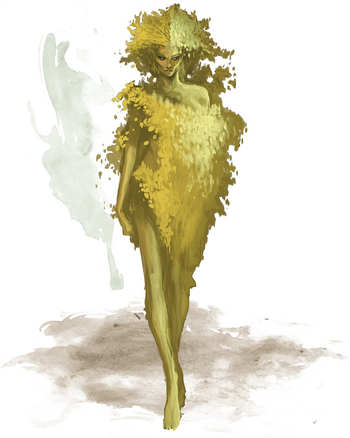
Dryad
- 5.5E/5E: Medium fey; neutral; CR 1
The Dryads are one of the many monsters that Dungeons & Dragons adapted from Greco-Roman mythology. Older editions of D&D adapted a whole plethora of different fairies and nature spirits, but 5th Edition – at least the base books – pares it down significantly. Dryads are the ‘face’ of the nature spirits due to how each dryad basically has a story baked into it by the nature (heh) of what they are. Later editions – particularly 4E – eliminates a lot of the monsters that aren’t there for hostile combat, which is a huge mistake. 4E notoriously turned the dryad into a boring giant wood-monster, and while the art is cool, it doesn’t feel like what a dryad should be – which is a bit more complex than that.
Dryads are fey that are tied to nature, and in most of their D&D history, each dryad is bound to a specific tree. The state of the dryad is bound to the tree – if the tree is healthy, the dryad is powerful. If the tree is sick and withering, so is the dryad. Thus, a dryad is highly motivated to protect the natural world around her root tree. 5.5E swaps this around to a tree or maybe a natural sanctuary (giving us a nice table to make it so that you can create dryads attached to more natural aspects other than just oak trees), but the idea is more or less the same – the dryad is wholly motivated to protect a certain part of nature. All of this leads to a nice little dilemma, because while it’s easy to imagine the dryad being an antagonist, the idea that the ‘monster’ is protecting her home can be a very sympathetic one.
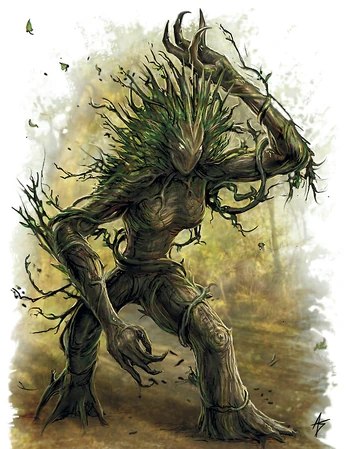


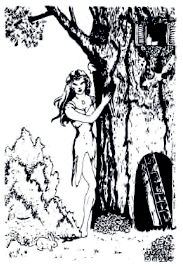
The original 5E Monster Manual gives us an interesting origin story for the dryads that is somewhat based on Greco-Roman mythology, where powerful archfeys will bind some of the lesser fey into trees as punishment if the fey falls in love with a mortal. This does not prevent the newly-formed dryad from falling in love with the beauty of a stranger, and they will sometimes charm away an individual. Again, all of these are great! There is definitely a place in these RPGs for monsters that are just there to menace you as a block of stats to engage with the mechanics, but ones like these – with more ambiguous motivations and tricks and gimmicks – are easily some of my favourites.
Visually, the dryad in 5E is a naked plant-woman with a ‘robe’ of leaves, and 5.5E gives us more variations with different plant elements to them – with the prose explicitly noting that dryads will take on aspects of the plants they are bound to. Abilities-wise, dryads tend to be a bit more on the trickier side, relying on communicating on woodland beasts to help them, casting druid spells and utilizing charm abilities to turn adventurers against each other, or just to get them out of the forest. Again, having a monster with a simple-to-understand, complex-to-interact-with motivation is a pretty great addition to the game. I really do feel like they probably should be a bit more powerful than the surprisingly low CR 1 they are assigned in 5th Edition.
____________________________________________________
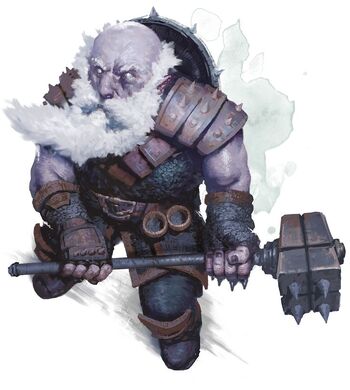
Duergar
- 5E: Medium Humanoid; Lawful Evil; CR 1
Everyone raised a fuss about the Drow and Orcs being gone from the 5.5E Monster Manual, but the Duergar is another one that’s just folded away quietly. Duergar, or Gray Dwarves, are essentially evil dwarves… but they are quite interesting! I’ve always had a soft spot for the Duergar. They have a very interesting backstory in the 5th Edition, primarily explored in the book Mordenkainen’s Tome of Foes, that describes their origin story. The Duergar originated as a greedy clan of dwarves that mined too deep in the mountains, breaching the Underdark and were found by the Mind Flayers. A war ensued which the Duergar lost, leading to their enslavement by the Mind Flayers. Generations of captivity, torture and experimentation led to the Duergar manifesting powerful psionic abilities, allowing them to overthrow their Mind Flayer oppressors. But when the Duergar came back to rejoin the rest of the dwarven society and asked the rather understandable question of ‘why didn’t you help us’, they were treated with a lot of political nonsense and religious fundamentalism, with the council that faced them essentially telling them that they deserved generations of enslavement and torture for being unfaithful to the dwarven gods. This led to rather understandable bitterness and war.
And I’m not saying that this is a perfect backstory, but it’s one that explains both the enmity of the Duergar and the Dwarves; while also not reducing the Duergar to ‘always evil’. It is vastly preferrable than not having a backstory as what 5.5E did to the Drow! Honestly, I kind of wished that we could solve this by doing what 3E did and just have a stat block for each generic member of each playable race, so we’d have humans, elves and gnomes in the Monster Manual alongside orcs and drow and goblins. After all, human bandits are just as cruel and evil as your average band of marauding orcs, and you’re just as likely to deal with an elven demon cult as you would to a rampaging dragon. It just feels so messy and confusing!
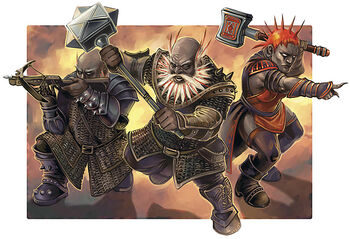


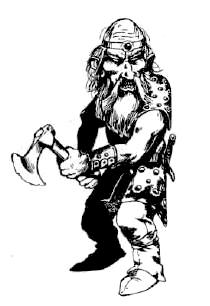
But we’re not here to talk about the real-life publications of these books and what goes into them, we’re here to talk about Duergar. And as I mentioned before, they are psionic – which means they have psychic powers! In some older editions psionics kind of screw over the system because they don’t interact with regular magic, but in 5E they’re just a different conduit for magical energy. Other books will introduce more duergar variants, but in the basic 5E statblock, Duergar are just really tough little dudes with the ability to go invisible, resistance against any mind-based attacks, and the ability to enlarge its size for a short period of time.
Duergar themselves are portrayed as being different to the regular type of dwarves – where dwarves are jolly and friendly, the duergar are suspicious and dour. Where dwarves put much love into craftsmanship and making works that will last for generations, duergar craft for quantity and for standardization. Where dwarves are staunch allies, duergar will break off alliances once they’ve gotten what they want.
____________________________________________________
Elementals
D&D did really popularize the fantasy trope of ‘elementals’. Creatures made up of a singly type of natural element, like fire or water, and having you just fight… fight that. It’s a pure manifestation of the natural forces of the world, incarnations that the D&D cosmology would establish as arriving from the ‘Elemental Planes’ connected to this world. The lore and the significance of Elementals have waxed and waned over the different editions – I remembered 4th Edition really pushing elementals in a lot of their core books – but they will always be important to D&D lore.

The older editions, particularly 2E through 4E, gets a bit crazy with Elemental variants, going from obvious ones to fusions to triple-fusions to esoteric planes… but for the most part, 5E keeps things basic and simple and has only the four primary elements of Greek mythology.
Actual Elementals themselves tend to be variations of the same theme – they are manifestations of their representative elements and have no real sentience. They may have some behaviours that one might interpret and assign human-like aspects to, like Fire Elementals being ‘hungry’ to burn, but for the most part they’re just creatures of instinct. Or, at least, those are the ‘lesser’ elementals. We have met the Azers before in this series, and we’ll talk about the Genies later on. These basic elementals are noted to often be summoned by conjurers, or simply manifest when a certain natural element is strong in an area.

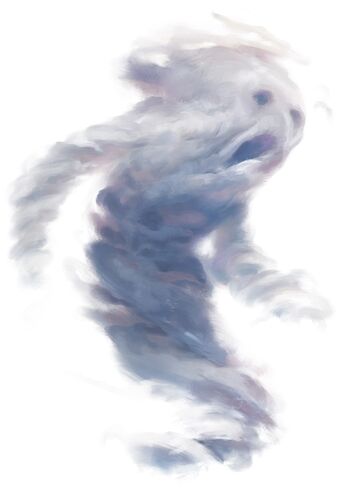
Air Elemental
- 5.5E/5E: Large Elemental; Neutral; CR 5
Most video games tend to have elementals be a ‘big ghost/genie-man made of a single element’, but I actually appreciate how variable D&D makes their elementals. The original 1E artwork is one of my favourites, being a literal swirling tornado with googly eyes. The 5E version is a mass of whirling winds and clouds with a moaning face and tiny ghost-hands, which isn’t the most threatening-looking design. 5.5E goes for a bit more haunting, showing a wraith-like humanoid figure reaching around the top of a sea.
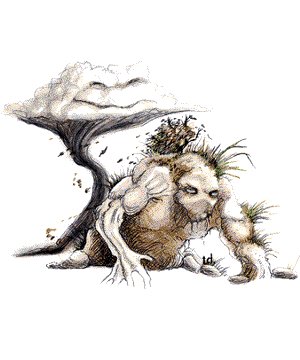
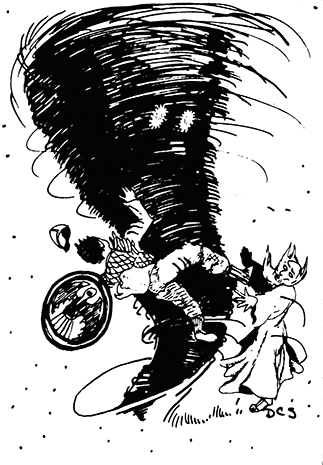
It should be noted that the Air Elementals are large, meaning that they’re the size of like dinosaurs or something. the 5.5E writeup gives each elemental variation their own page and expands on them a bit more, although they just tend to be variations on the appearances. I do like it though, since ‘Air Elemental’ doesn’t quite as readily conjure a mental image as easily as Fire, Earth or Water does. There is a nice table that lets you customize your Air Elementals, going from vibrant colourful gases, a pungent miasma, cumulus clouds or storm clouds… which really makes the Air Elementals potentially a lot more flavourful than just ‘angry tornado’. They might be angry stormy tornadoes, or the manifestation of a mysterious mist, or manifested from poison gas. Neat stuff.
Air Elementals can hit you with thunderclaps, and can move into small places because it’s made up of air, but probably the coolest gimmick attack it has is ‘whirlwind’, which has the Air Elemental tossing people into the air.
____________________________________________________

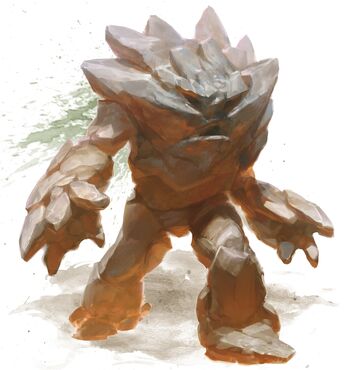
Earth Elemental
- 5.5E/5E: Large Elemental; Neutral; CR 5
The representatives of Earth tend to look relatively ‘samey’ to some other creatures in the game, like clay golems or galeb duhrs or whatnot. But it is also a bit harder to make them feel as exotic of a design like the other three elementals for the simple reason that Earth is an element that real people, in the real world, can mould into humanoid figures. So it doesn’t look as eerie as a quasi-humanoid visage made up of fire or water.
5E gives us a big lumbering rock-man whose face is carved on a huge slab of rock that serves as its chest-head. It’s a bit goofy, especially compared to the more threatening (if admittedly ‘obvious’) hulking, lurching hunchbacked earth monster with beady eyes from 5.5E. Again, 5.5E gives you a table to customize your Earth Elementals. Sometimes they are made of sand, sometimes they have mineral formations, or magma veins, or decaying plant roots in their body. Unfortunately, the Monster Manual doesn’t actually give any differences based on these dice results, but they should, right? An Earth Elemental born out of volcanic slag should be dealing extra fire damage. An Air Elemental manifested from the miasma of a swamp should be able to choke someone out with poison.


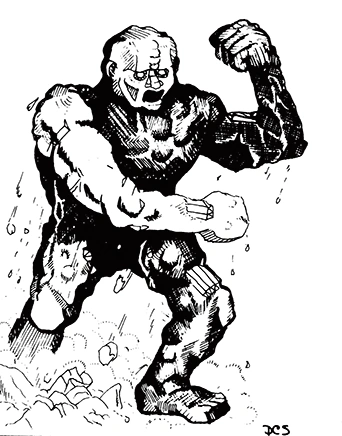
The Earth Elemental attacks by hitting you with rocks, either with its rock fists or lobbing rocks at you. Most cool and possibly unexpected, however, is its ‘earth glide’ ability where it just burrows through the earth without destroying or displacing much. It also has ‘tremorsense’, an ability shared by many other subterranean creatures that allows it to pinpoint where other living creatures are.
A brief note is that a lot of the Elemental art for previous editions like to lump multiple elementals in a single picture (particularly the 3E and 4E art I used in the earlier 'Elemental' writeup). I think it's obvious enough to see which is which, and for the sake of the page's image count I shan't put every single picture on every single entry.
____________________________________________________

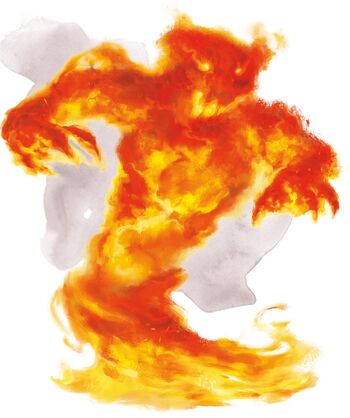
Fire Elemental
- 5.5E/5E: Large Elemental; Neutral; CR 5
We have the Fire Elemental, and I’ve always found it glorious that the original Fire Elementals were just… a little campfire with two little eyeballs. It is glorious! The artworks would be standardized into the ‘spectral fire genie’ design alongside many other non-D&D affiliated games that find it a nice way to communicate the essence of the creature without being too whimsical.
The type of face you put on the elemental does really matter, though. 4E goes for a venus-flytrap mouth. 5E gives us a growly-looking features made up of flames. 5.5E goes for the ‘beady eyes’ look again, although the darker, more distinct ‘head’ does make it look a bit more threatening.
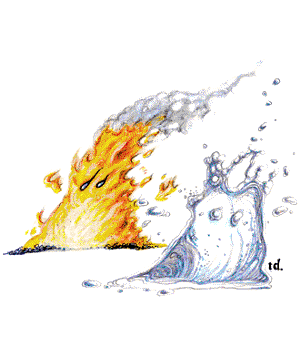
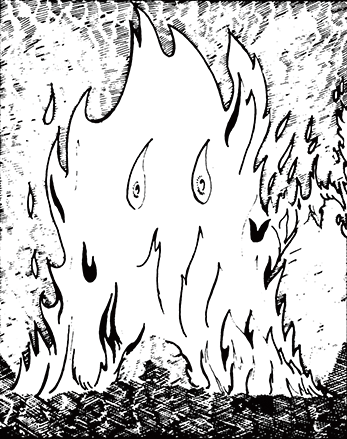
Fire Elementals tend to be depicted as the most readily aggressive and expansive element, just like real fire. Again, I like that 5.5E gives us another table to modify fire elementals, though it is admittedly reaching a bit compared to the other three. I do like the idea of a Fire Elemental constantly emitting ‘colourful, superheated gas’, ‘soot that smells like incense’ or just flames of different colours. There’s also the rather obvious Ghost-Rider-esque ‘form of a humanoid’ within the Elemental visual variant.
Interestingly, the Fire Elemental is the only one of the four to have a Pokemon-esque ‘type matchup’, because it gets damaged rather rapidly if someone douses it with water. In exchange, it constantly just exudes an aura that sets everything on fire.
____________________________________________________

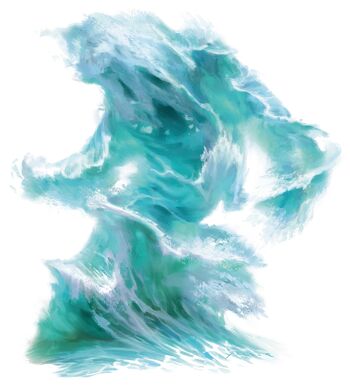
Water Elemental
- 5.5E/5E: Large Elemental; Neutral; CR 5
Again, shout out to the original 1st Edition Water Elemental. It’s a cartoon wave, like an ocean wave, with eyes and little punching-glove nubs for hands. 5E gives us a misshapen wave-like humanoid with a sad ‘scream’ face on it, while 5.5E throws in a more threatening-looking humanoid with a face that has smaller, more threatening features and more distinct hands. On one hand, I could see the design philosophy behind the sillier interpretations of an elemental. On the other hand… I have been a bit too used to fantasy video games like World of Warcraft showcasing elementals in forms not too dissimilar to the 5.5E design, so I don’t mind them looking a bit more threatening.
Again, it’s a nice reminder that these basic Elemental statblocks are large creatures, and one of these Water Elementals would be enough to upend an entire dock. Being made up of water, they could slam with the force of a rushing tsunami… or seep through cracks insidiously. They also have an ability called ‘whelm’, which honestly is more correctly described as drowning its opponents. Sadly, despite the many, many different types of liquids and water variants out there, we’ve only got four appearance variants in the 5.5E tables (hot/cold, glowing, muddy and with fish inside)

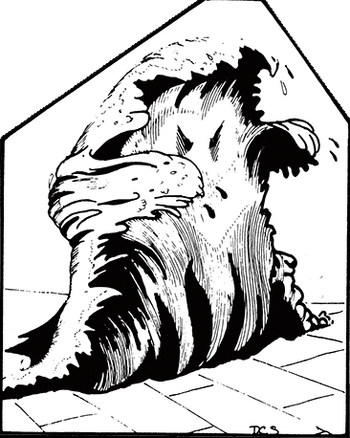
Overall, the Elementals are always something that has been a nice, simple staple of fantasy to me. They can’t be too complicated, and making them complicated, I think, defeats the whole purpose of the basic elementals... no, for more elaborate stuff, you go to things like Water Weirds and Invisible Stalkers. It is kind of interesting to see the different design choices of Elementals over the various editions. While I normally celebrate the goofier aspects of D&D’s history, for the Elementals I will very happily admit that the more threatening modern Elementals are pretty cool.
____________________________________________________

Elemental Cataclysm
- 5.5E: Gargantuan Elemental – Titan; Chaotic Neutral; CR 22
A newcomer to the new ‘5.5E’ Monster Manual is the Elemental Cataclysm, our ‘titan’ for the elemental type of creatures. It’s a being created from the parts of the Elemental Chaos where different elements clash and roil onto each other, and the terrifying collision points give rise to beings that are amalgamations of all four primary elements. D&D has had ’fused’ elementals through its various editions, with 3E and 4E giving us a lot of alternate variations of these multi-elementals. The Elemental Cataclysm is a much, much larger and meant to be an end-game boss.
The design of the creature is impressive, although hardly new for D&D. It’s a titan with four serpentine or draconic heads, bringing to mind the visuals of a hydra or Tiamat herself. The difference is that the heads correspond thematically to the four primary elements. Or, well, at least three of the heads are made up of water, flame, and storm-clouds… and the fourth head is made of sleek green metal and poison. The ‘earth’ part fits the body of the creature more. But thematically it’s there, and people more familiar with 5th Edition lore and subsequent bestiaries like Volo’s Guide to Monsters would probably note the similarities between the four heads and the four ‘elder elementals’ introduced in that book – the leviathan, the elder tempest, the phoenix and the zaratan. Again, the ‘earth’ head is the odd one out in that it doesn’t really resemble the tortoise-like zaratan that much, but there are hints of the other three here.
Ability-wise, it has attacks themed on the four elementals as 'breath weapons', with the earth head shooting out acid. Far more interesting is that this Godzilla-sized being has the same 'earthglide' ability that basic Earth Elementals have, allowing it to just zip across the crust of the earth and burst up in the middle of cities if it so chooses.
I do appreciate the writeup giving us more than just ‘big elemental Tiamat’, because while the Elemental Cataclysm has a couple of interesting behaviours instead of just rampaging around like a kaiju. They abhor anything that ‘mars nature’, so anything man-made (or humanoid-made) like cities, mines, monuments… and are noted to particularly hate metal and clockwork. So essentially, technology. So while they destroy everything in their path, they direct their roiling rage towards anything created by despoiling nature. It is quite interesting! I do like that once an Elemental Cataclysm has been banished or destroyed, the Monster Manual also gives a table of the environmental changes created in its wake, which could be destructive like a never-ending storm or a permanent change in temperature… but also bountiful to nature, such as the growth of a gigantic coral reef, a rapidly growing rainforest or the revitalization of a previously extinct animal species. It’s a nice nod to how the elements are supposed to represent both the destructive and constructive parts of the natural world.
____________________________________________________


Empyrean
- 5.5E/5E: Huge Celestial/Fiend – Titan; Neutral; CR 23 (Empyrean)
- 5.5E: Medium Celestial/Fiend – Titan; Neutral; CR 1 (Empyrean Iota)
The Empyrean is a monster type that’s kinda-sorta new to 5th Edition. Lore-wise, they function similarly to the ‘Titan’ enemies of previous D&D editions (whose pictures I also feature here), which are super-giants that are close to the gods. With ‘Titan’ being used in 5th Edition as a term to refer to any large, high-CR ancient monster, it really does seem that the Empyrean are retooled versions of the Titans.
5E’s take on the Empyreans essentially describes them as being Greco-Roman demigods, although with more power. The artwork shows a mighty warrior with marble skin, towering over mortals and wielding massive weapons. Slightly stiff pose aside, it’s a simple design to ‘get’. These CR 22 creatures are noted to be ‘celestial children’ of the gods, and this quality causes them to warp reality around them with their emotions. Somewhat based with the more capricious gods of certain mythologies, the Empyrean changes the environment and weather around them based on their moods. 5E also describes ‘evil’ Empyreans, which happens 25% of the time apparently, where they become evil and corrupted by the lower planes, and they want to rule over mortals as tyrants.



5.5E gives us a bit more of an expansion on this creature that honestly wasn’t the most interesting. Playing less on the ‘their emotions affect the nature around them’ stuff, Empyreans are either ‘celestial’ or ‘fiendish’ depending on their parentage, and they have features that are a bit more representative of the concepts of nature. So an Empyrean born of a god relating to fear would have a morbid and monstrous appearance that might reflect the viewers’ fears. One born of a god of order might be machine-like and stoic. The 5.5E Manual makes it a bit more clear that each Empyrean’s relationship to their godly parents are going to depend a lot on your setting and the specific gods of that setting. Are they servants? Favoured children? Rebellious children? Inventions? Abominations spurned by their creators? It perhaps requires more work, but it makes a lot more sense than the more basic 5E writeup.
5.5E also gives us a cute little CR 1 variant, the Empyrean Iota. In that artwork, the Iotas are the little glyph-like things surrounding the two humanoid titan Empyreans. Iotas are described to be formed out of the personifications of thoughts and memories of deities. They kind of serve as the god’s servants, essentially functioning as weak messengers of the celestial side of a setting. Iotas are still fully sentient and can cast spells. All of this ties to ways for a DM to incorporate the gods of the setting without having the gods – or the more powerful angels – show up.
I was fully bored with the original 5E Empyrean beyond the novelty of talking about a being technically debuting in 5E, but the variations that 5.5E introduces does make them a bit more interesting.
____________________________________________________

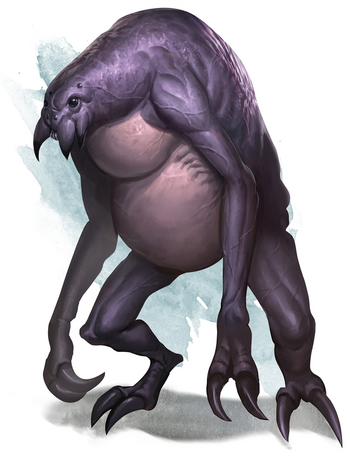
Ettercap
- 5.5E/5E: Medium Monstrosity; Neutral Evil; CR 2
Yay, the Ettercap! The Ettercap has always been a personal favourite, being a strange spider-monster… that isn’t actually a spider. In fact, in the Ettercap’s earliest appearance, it looks more like a weird mutant troll. As the versions go along, the Ettercap has evolved into a pudgy, bipedal figure with a bug’s face, some hooked claws, and the ability to create webs. I do like this weirdness where, yes, they have some spider-y features, and they even get along with spiders and keep giant spiders as pets… but they are themselves not quite spiders.
The 5E design (as did the 3E and 2E) goes for this mentality, giving us a pudgy and very fleshy humanoid. 4E goes a bit too far in making its Ettercap into a generic bug-man, which makes it lose its individuality compared to the other bug-people in D&D… but 5.5E interestingly splits the difference in still having a similar design, but giving its Ettercap a slimmer body, more prominent chitinous armour and bug-joints, and a very creepy head… but doesn’t go ‘too far’ and it still kind of looks like a spider-ogre you’d find in a tokustatsu show or something. I am a bit torn about this. On one hand, the Ettercap not being fully arthropodal always felt like its more striking aspects to me. On the other hand, I can’t deny how cool the 4E and 5.5E artworks are.

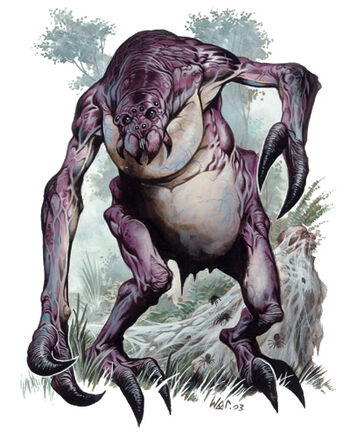

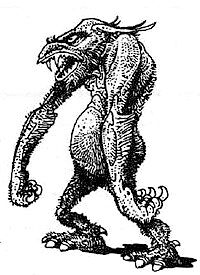
As I’ve mentioned above, the whole idea of Ettercaps are that they’re semi-intelligent humanoid spiders. They create webs, they shoot webs, they scuttle on walls, and they are so attuned to actual spiders that they hunt with giant spiders or spider swarms. That last bit is described by the 5E manual as being akin to a shepherd tending its sheep, which is cute. Ettercaps are noted to be an unnaturally destructive species, often overhunting their environments and cocooning every living thing in the area. This leads them into conflict with fey, which the 5.5E artwork showcases by having its Ettercap torment a fairy it’s captured. They’re also intelligent enough to stalk its prey, and to torment the ones they’ve captured.
Any giant bug monster is sure to find a way into my heart, and the Ettercap definitely is one of my go-to monsters for a basic early game encounter with a bit more flair than just another goblin or bandit group.

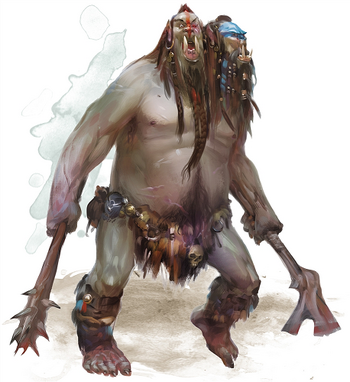
Ettin
- 5.5E/5E: Large Giant; Chaotic Evil; CR 4
One thing that my D&D monster reviews will make clear is that I’m not the biggest fan of “this is a guy, but big”. Which was why the giant-themed sourcebook Glory of the Giants took me so much longer to review compared to any of my other D&D content. Even discounting the giants of the ordning, each main D&D manual usually also contains cyclopes, fomorians, ogres, trolls and ettins. I just don’t find ‘big dude’ that interesting, especially not when you can throw ‘big metal golem dude’ or ‘big fire elemental dude’ or ‘big acid-breathing dragon’ or ‘big four-armed dog-crab demon’ at your adventurers instead.
The Ettin is just… a two-headed giant. It’s got all of the negative aspects you associate with a big storybook giant. It’s dumb, it’s smelly, it’s grumpy, it’s violent. Its two heads each have its own personality, and they keep fighting over what to do – a pair of twin brothers or sisters that are always, always fighting. The only time that the two heads are together are when they’re united to fight enemies, although the Manual insisting that ‘each head can direct each hand separately’ isn’t much of an advantage when dual-wielding is so common in fantasy-land.

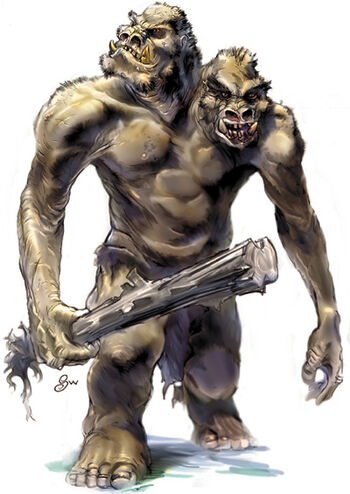

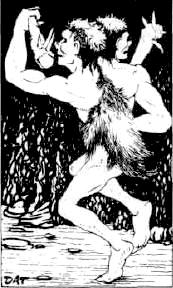
The 5E Manual actually gives an origin story for the Ettins, noting that they are orcs cursed by Demogorgon and given a giant two-headed appearance based on the Demon Lord’s appearance. This has apparently inspired the ‘orc-like’ appearances that the Ettin has, which mostly just extends to the tusks. 5.5E gives us a table of alternate quirks that the two heads’ dynamics might have instead of just always fighting, but I honestly don’t find them particularly exciting. They are, by the way, impossible to catch sleeping because one head always stays awake... which is good for exactly one time to surprise your party by having a clearly snoring Ettin in the way, but one of the heads is actually keeping watch. They’re not the most boring giantkind, by the inherent comedy that DM’s can have roleplaying Ettins, but otherwise… eh.
____________________________________________________

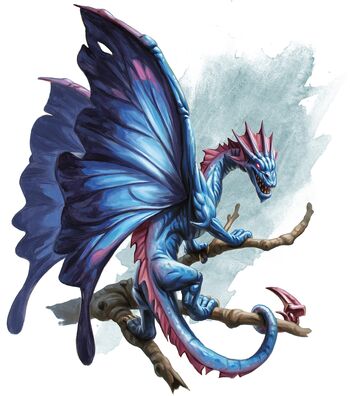
Faerie Dragon
- 5.5E/5E: Tiny Dragon; Chaotic Good; CR 1 (Faerie Dragon Youth/Red, Orange, Yellow)
- 5.5E/5E: Tiny Dragon; Chaotic Good; CR 2 (Faerie Dragon Adult/Green, Blue, Indigo, Violet)
I try to keep each monster review more or less self-contained to the franchise I’m talking about, but it would be hard for me not to mention the Warcraft franchise when I’m talking about Faerie Dragons. I was introduced to their adaptation of the Fairy Dragons from Warcraft III and I thought that it was so cool to have these flittering, playful little frog-dragons with butterfly wings. Warcraft, of course, drew a lot of inspiration from D&D, and these little tiny gremlin-dragons originating from the Feywild has always been a personal favourite.
Their appearances have differed over the various editions, of course, but with the Fey I always felt like they wouldn’t have a ‘standardized’ appearance. 5E’s take on the Faerie Dragon gives it a neon blue colour with pink highlights, and a very draconic face. 5.5E gives us a pair with more elaborate butterfly wings, and heads that look like cartoonish pterosaurs. With the chaos inherent to the Faerie Dragons, I feel like they would have a lot of variation among them.
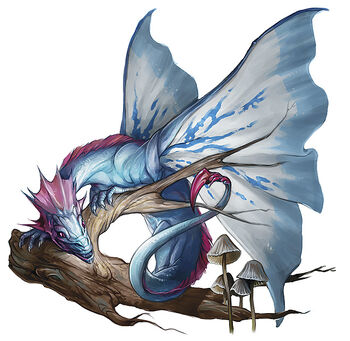


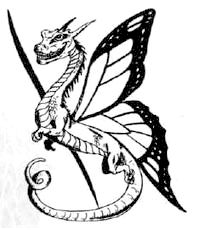
Faerie Dragons are little tricksters happy to play mischievous pranks on people they pass through, stalking anyone that wanders into its territory and playing (mostly) harmless pranks until they are sufficiently satisfied enough and they’ll reveal themselves to their victim and maybe newfound-friend. They’re like hyper-intelligent spellcasting cats, which describes faeries very well.
Being dragons, Faerie Dragons technically have a breath weapon called ‘euphoria breath’, which causes its victims to move in a random direction or to just stand still doing nothing. Which is a PG-13-rated version of hallucinogenic drugs. They also collect treasure, but they are easily bribed with cookies or any cheap bauble. These guys had their ‘lore’ section truncated into three sentences in the 5.5E in favour of splitting its stat-block into two. It’s a bit silly, since 5E already has the solution by noting that Faerie Dragons go from red to violet (the colours of the rainbow) as they age, and they just learn a new illusion-themed spell as they grow older. Bit of a shame that 5.5E reduces so much of the lore in favour of an extra stat block variant.
____________________________________________________

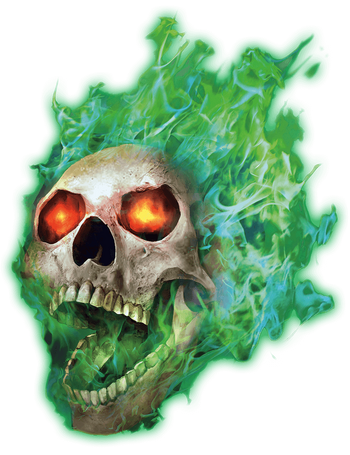
Flameskull
- 5.5E/5E: Tiny Undead; Neutral Evil; CR 4
Interestingly, not the first flying undead skull in the Monster Manual. The Flameskull is a flying undead skull cackling with anger. It’s also on fire! Flameskulls are created from the corpses of evil wizards – though they don’t retain a lot of memory of their past life – and flying around as burning skulls, they are able to cast spells like magic missile, mage hand (very useful if you are just a head), and good ol’ reliable fireball. Also, it’s one of those undead that will pop back to life after being destroyed, unless you do a holy ritual.
Again, in an attempt to make the actual sentient undead like liches and vampires more special, a Flameskull is a mere echo of its previous life. It has access to the wizard’s destructive spell without having to use material and somatic components, but the best it can do is ramble echoes of its past life that it doesn’t fully comprehend. 5E notes that the Flameskull is explicitly created and bound by its creator, usually sent to for the purposes of being a guard minion.


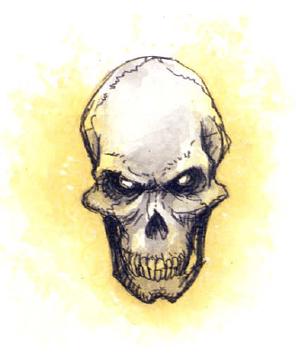
5.5E gives us a bunch of Flameskull variations in its artwork, with two of the Flameskulls being made up of the skulls of a dinosaur and an ape; and also gives us a table of other alterations one might find on a Flameskull like arcane diagrams, flames shaped like hair, the Flameskull being a mass of fractured pieces that fly in unison, or just ‘lethal head trauma’. It’s all right. It’s an angry flying Ghost Rider head.
____________________________________________________

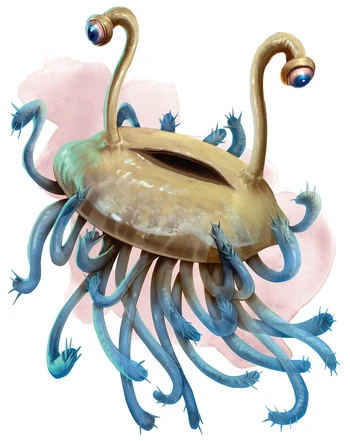
Flumph
- 5.5E/5E: Small Aberration; Lawful Good; CR 1/8
My boy, the Flumph! I love the Flumphs. Perhaps one of the more iconic monsters in D&D, the Flumph was introduced in the 1st Edition’s ‘Fiend Folio’, a book that introduced to us a lot of other iconic monsters… and among the many, many creatures within was a little strange being that lived in the terrifying Underdark, a little sentient jellyfish with cartoon eyeballs that moves around with farts. It’s called the Flumph, and it is continually jeered and mocked as part of ‘old D&D is dorky’. As the editions moved to the more serious, darker-and-grittier 3rd and 4th Editions, the Flumph was barely acknowledged, if at all.
And the Flumph is silly. It’s meant to be! It’s a pancake-shaped colourful jellyfish with eyeballs on stalks, a huge mouth and lots of tentacles. The artwork has gone a bit back and forth on it (with its sole 3E art making it a fair bit less whimsical) but for the most part, it is a creature that by design is meant to be adorably goofy-looking. And that’s honestly important – one criticism that I do have with a lot of settings is that if everything is an over-the-top monster, then nothing is. And having an alien species for adventurers to rescue is just as important of a narrative space than the monsters they have to cut down. As the editions went along and the nerd community matured, there’s been a nice resurgence, and the Flumph made its return in 5th Edition in the pages of its core material and has actually been utilized quite significantly in a lot of artwork. Not bad for the subterranean fart-jellyfishes that had spent most of its career being relentlessly mocked!
But what is the Flumph? Flumphs are classified as an aberration, a classification that tends to be reserved for beholders, aboleths and mind flayers. A classification that meant unnatural, the strange, the ones that break the physics of the world, the eldritch, the other. And I suppose it makes sense that there is a being among the aberrations that is itself an aberration to the aberration category itself – a good-natured being with no real ability to defend itself. Indeed, while a Flumph can communicate telepathically, it can’t fight with psionic abilities. It has a little tentacle attack, and can unleash a stench spray… something that makes the Flumph barely more threatening than a skunk. And, again, the Flumph shares its Underdark home with the aforementioned Aboleths and Mind Flayers.
They move around with ‘air jets’, which apparently gives the Flumphs its name. A hold-over from the original 1st Edition writeup is that Flumphs have a ‘prone deficiency’ thanks to this air jets. A Flumph that has been knocked upside-down has a chance to be stuck and be unable to move if its air jets are blocked, adding a layer of pathetic cuteness to it. Again, there is a nice layer of ‘anime mascot’ or ‘rescue this sad dumb puppy dog’ vibe to the Flumphs.

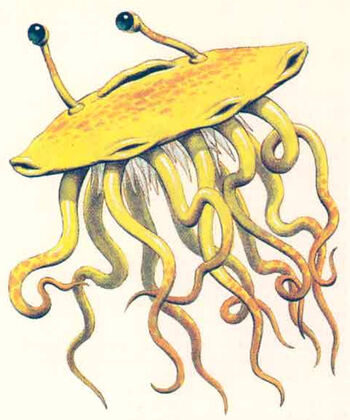
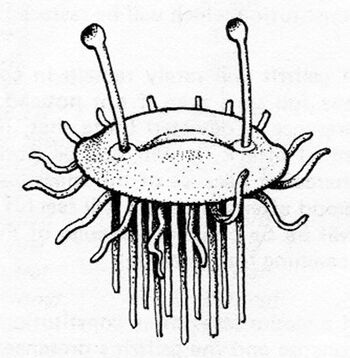
Previously all Flumphs are yellow, but 5E makes them colour-changing creatures, with the colours of its tentacle extremities reflecting its moods. The 5.5E Manual in particular gives us a table for a lot of its colour-to-mood translation, including some obvious ones (red is angry, dark blue is sad, light blue is happy) and I like that there’s a nice sign that the Flumph also has ‘access’ to some emotions that are incomprehensible to humans.
The original 5E writeup also has a bunch of writing that helps to integrate the Flumph into a campaign instead of just an oddity you find as you explore the Underdark. Flumphs are noted to be ‘psionic siphons’, an addition in 5E. They siphon mental energies from psionic creatures, but in a harmless way that doesn’t hurt the ones they feed on. However, since most of the creatures in the Underdark are evil, this stresses out the poor Flumphs who are subjected to the dark thoughts and emotions. This leads them to easily be attracted to the non-evil adventurers that come down into the Underdark, both because they’re a less-toxic source of psionic energy, but also to tell them about all the evil creatures around them. It is admittedly a bit too on-the-nose as a ‘quest giver’, but it’s also a bit dependant on the DM himself on how accurate the Flumph’s information is. 5.5E notes other ways that a Flumph could offer ‘help of dubious use’, from reasonable attempts like being a guide to items or enemies; nursing fallen adventurers; cooking a meal of Underdark delicacies… or doing something cutely silly like ‘performing a psychic song or smell poem’ or just sharing encouragement and praise. And you know what? I, too, would like a floating Flumph buddy to give me praise as I go and fight the big bad evil guy!
____________________________________________________

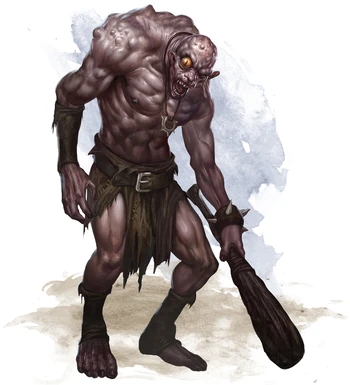
Fomorian
- 5.5E/5E: Huge Giant; Chaotic Evil; CR 8
Despite the little rant against giants in the ‘Ettin’ part, I actually do have a soft spot for the Fomorians. The Underdark has a lot of twisted versions of creatures from the above-world, and the Fomorians are the evil subterranean giants, being twisted and deformed. In most depictions, they have a hideous hunchback and one particularly larger eye and larger arm. Not too obvious in 5E, which just looks like an ugly dude. 5.5E goes a bit more intense with the depiction, giving its Fomorians such deformity that their upper bodies are giant clumps of flesh riddled with creepily glowing pustules.
Their backstory is an interesting one, where they used to be a tribe of very beautiful giants that tried to wrest control of the Feywild’s magics for themselves through deadly treachery… and got found out, cursed, and warped into being ‘as ugly as their insides are’ as they fled to the Underdark. That little karmic curse is probably one of the more interesting things and something very interesting from the archfeys' standpoint. Their attacks tend to revolve around passing the curse to their foes. 5E has an ‘Evil Eye’ mechanic, while 5.5E has a more variable hex that could cause anything from wandering pustules to wriggling hair to appear where the Fomorian cursed you.
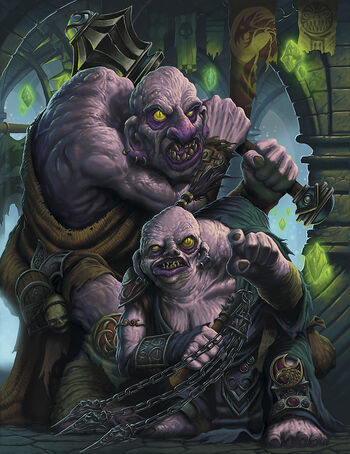


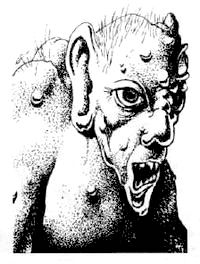
The Fomorians, despite being giants, are able to thrive in the Underdark – which are a system of subterranean tunnels. They tend to be portrayed as capturing other sentient species and enslaving them, and that’s when they’re not attacking them. It’s a bit boring, honestly, though I really like the depiction of a Fomorian variant in Glory of the Giants that showcases them being able to twist their joints like a contortionist to move through tunnels – which is probably the only time in D&D’s history a Fomorian has actually ever been properly interesting to me as a ‘monster’ beyond its backstory .
Anyway, because I didn't know how to organically mention it in the bodies of the reviews, I would like to note that the Fomorians draw their name from a type of supernatural evil spirit from Irish mythology, though 'real' mythological Fomorians tend to be associated with the ocean. Ettins, meanwhile, draw their name from Old English (which just means 'eating', as it they're big enough to eat men).
No comments:
Post a Comment